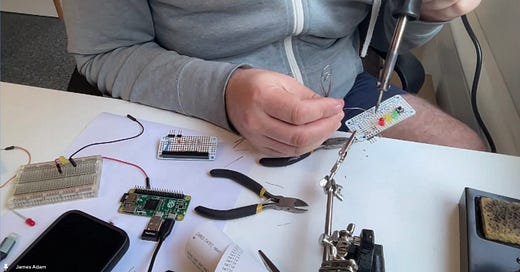1. The Week That Was
Excuse me, dear readers, but I’m a little distracted at the moment by the Djokovic vs Alcaraz slugfest (as of right now: both are hurt, and Alcaraz is throwing the third set so he can go back to the locker room and recuperate before the fourth) as I try to write our weekly recap.
It’s been quite a week! Apple showed off a pair of magical goggles billed as “the ultimate theater.” Coincidentally, this week we’re launching Good Enough TV––the ultimate destination for the finest video content on the internet. And you can start enjoying all of these videos today, right now, without any new hardware, for free. You’re welcome, friends.
Aside from watching and recommending videos, we’ve been working hard on other projects (a total of five, in fact) and great progress has been made this week. Barry built Good Enough TV and he’s been doing a bit of quacking. Patrick and I worked on a very silly thing a week ago, which led him to an idea that Arun has then taken on (yay!). Lettini has been designing a Mac App, which James is calling Chicken (more on this below). And speaking of James, he’s been doing some soldering at his desk. Careful, mate!
Update: it seems that Carlitos is hurt and the match has gone one way and, not to disrespect Zverev or Ruud, Djokovic will break Nadal’s record this weekend. (And really, do you think anyone can touch Djokovic on grass come July?)
We hope you have the ultimate weekend and may the air you breathe be free of toxins. ––SL
2. Welcome to the High Street
One of our maelstrom prototypes has – for now at least – been given the codename Chicken. Discussing this, I used the phrase “high street”, to the significant confusion of my New World colleagues.
I’ve spent a lot of time in the US and I thought I’d discovered all of the phrases and concepts that required translation between our two Great Peoples, but it had never occurred to me that the phrase “high street” would mean nothing to someone, since it’s so ingrained in our lives here.
So, to forge an even stronger Special Relationship, let me explain: whichever nearby street has the greatest concentration of shops is non-specifically known as the “High Street”. It’s more of a concept than an actual street; economists discuss “problems on the high street” when talking about the retail sector. Disney calls it “Main Street”, although I’ve never seen any shops populated with animatronic dead presidents in any of the UK cities I’ve lived in.
More importantly, and relevantly: it’s wherever the highest concentration of fried chicken shops in the area is. So now you know. —JA
3. Arun-inations
It’s not what you think it is.
If you stop to think about that, to feel into it, you might notice something interesting: that it’s true.
No matter what the “it” is!
For any given “it” – a cat, a concept, a cotillion, a cathedral – there are two things: what you think it is, and what it actually is. At one level, this is a trivial statement. Of course the thoughts we have aren’t the things that the thoughts are about.
That’s obvious when said out loud, but it doesn’t change the fact that you’re probably still doing it.
A lot.
Basically all the time.
We all do, and it’s normal. When we perceive something, we categorize it almost instantaneously. That’s a bird. That’s a website. That’s late-stage capitalism. That’s Shia LaBeouf. Those are all convenient labels! But they are not, in themselves, what they’re referring to.
And if you look around, you might start to notice that people are responding to and interacting with the labels rather than the experiences the labels are pointing to. In other words, living in a dream world.
There’s infinitely more to say about this, and infinite ways to say it. Instead, I’ll offer up a little practice you can do to loosen the grip of the Tyranny Of The Label:
Choose something you’re seeing right now. (This works with any experience, but seeing is a good/fun place to start)
Keep noticing whatever it is, and wait for a label to come to mind. For example: “coffee mug”.
Notice that there are, in a sense, two experiences: the experience of the label (the thought “coffee mug”) and the actual seeing of what you’re labeling a coffee mug – the form and colors and shapes.
Hold both experiences until it becomes crystal clear which one is which. At the start, the two experiences might seem to be tangled or mixed with each other.
Release the label and focus solely on the underlying experience.
Observe whether anything about your perception of it changes.
Repeat as necessary or desired.
More labels may show up, or the same ones again and again. If you want to, you can keep noticing them and letting them go. You can also explore “de-labeling” feelings, sounds, smells, and even thoughts themselves. Explore and enjoy! Alternatively, you can not worry about any of this. That’s great, too! ––AS
4. In Conclusion: Stickies
One of our team (Shawn) asked:
I want a post-it sticker kind of thing on my desktop so I can put my daily agenda there for quick reference. Is there something like that today?
It was with great joy that a number of us suggested the macOS Stickies app. Sometimes the newest of discoveries debuted in 1994. Here’s to new discoveries for each of you! ––BH








